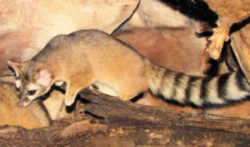Arizona State Mammal
Ringtail

(Bassariscus astutus)
Adopted in 1986.
The ringtail (Bassariscus astutus) named the state mammal of Arizona in 1986. It is not really a cat but is related to the raccoon and coatimundi. The ringtail is also known as the ringtail cat, miner's cat, and cacomistle. Ringtails are cat-sized carnivores resembling a small fox with a long raccoon-like tail. The tail is about the length of the head and body with 14-16 black and white bands and a black tip. The ringtail. Five toes on each foot are equipped with sharp, curved, non-retractile claws.
Arizona State Mammal: Ringtail

The ringtail, Bassariscus astutus, also known as ringtail cat, miner's cat, and cacomistle, is not actually a cat but is related to the raccoon and coatimundi. Ringtails are small and slender and about 2 1/2 feet long. Half of a ringtail's length is its bushy tail which is ringed with black and white. Its coat is grayish-buff and is darker along the back with pale under-parts. Its fox-like face is dominated by huge, round eyes which are ringed in white. Its ears are large and rounded. The ringtail's claws, like a cat's, are partially retractable. Its Latin name means "smart little fox."
Ringtails are found in a wide variety of Arizona habitats, ranging from the Sonoran Desert to coniferous forests. They prefer rough, rocky areas with caves, crevices, and broken ledges in which to den. They often use mine tunnels as retreats and may also use hollows in trees for dens. Ringtails breed from February through May. They usually have 2-4 young which are born from May to July. The young are blind at birth and are covered with downy white fur. The young begin foraging with the adults at two months and are weaned at four months.
Ringtails are omnivorous, feeding on a wide variety of fruits, berries, insects, lizards, frogs, birds, and rodents. Ringtails are efficient and effective predators. They are especially fond of wood-rats and are known to take over their dens after first consuming the occupant. In turn, ringtails are preyed upon by larger predators, particularly the great horned owl, coyote, and bobcat. Ringtails, except when with young, are solitary creatures. They have considerable adaptations for surviving in hot desert habitats, including improved efficiency in body heat dissipation through panting and the ability to greatly concentrate their urine. They are shy and nocturnal and thus are seen by few people. Although the ringtail is listed as a furbearer in Arizona, it is not harvested in large numbers because the fur is not highly valued. The ringtail is not considered threatened or even rare, just secretive.
Arizona Laws
As a result of the statewide contest, a mammal, a reptile, a fish and an amphibian were adopted at the same time and codified under one section, titled "State animals".
The law designating the ringtail as the official Arizona state mammal is Section 41-859 (State animals) of the Arizona Revised Statutes, Title 41 (State Government) Article 5 (State Emblems) Section 41-859
TITLE 41. STATE GOVERNMENT.
ARTICLE 5. STATE EMBLEMS.
41-859. State animals. The ringtail or bassariscus astutus, the Arizona ridgenose rattlesnake or crotalus willardi, the Arizona trout
or salmo apache and the Arizona tree frog or hyla eximia shall be known respectively as the state mammal, reptile, fish and amphibian.
Taxonomic Hierarchy: Ringtail
Kingdom: Animalia
Phylum: Chordata
Class: Mammalia
Order: Carnivora
Family: Procyonidae
Genus: Bassariscus
Species: B. astutus








